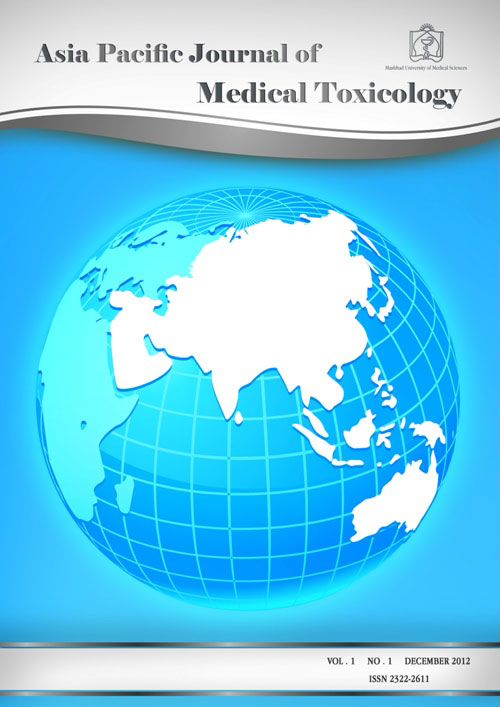فهرست مطالب

Asia Pacific Journal of Medical Toxicology
Volume:6 Issue: 1, Winter 2017
- تاریخ انتشار: 1396/02/21
- تعداد عناوین: 7
-
-
Pages 1-5BackgroundAlcohol-related disorders are among major public health problems around the world. We aimed to focus on the trends of alcohol intoxication in Mashhad for the recent seven years.MethodsRegistry database was analyzed. All admitted cases with alcohol-related intoxication were included during 2004 to 2011. Two national censuses were used for rate calculation.ResultsThere were 772 admissions due to alcohol (ethanol and methanol) intoxication (1.6% of all poisonings which equals to a prevalence rate of 3.3 per 100,000) during the 7-year period. Mean age was 25±11.9 years, and 90% of subjects were male. Alcohol intoxication prevalence was tripled as compared to 2004. Case fatality rate was higher in women (7.5% vs. 6.6%). Males who were self-employed or unemployed and females who were housekeepers or students were at greatest risk. The age-specific prevalence rate was highest in 10-20 (6.25 per 100,000), and the age-specific mortality rate was highest in 30-40 (2.13 per 100,000) age group.ConclusionIt seems that current health policies need to improve regarding complications of alcohol use in the area to effectively control the increasing rates. Further national studies are warranted.Keywords: Alcohol, Epidemiology, Poisoning
-
Pages 6-11BackgroundSeveral studies have reported the toxicological implications of inhalation of petroleum hydrocarbon fumes in animal models. But, there is certainly little or no documentation of the exposure to petroleum hydrocarbon fuel on oxidative stress levels in humans, unlike the pulmonary physiology. The present study was carried out to evaluate the effects of constituents of the hydrocarbon fuels on oxidative stress levels of the petrol fillers and tanker drivers.MethodsThe study involved 165 males divided into three groups were the petrol fillers, tanker drivers and the controls. Case control data set was established wherein the control subjects are not exposed to hydrocarbon fuels with similar age. Serum samples of the subjects were collected and subjected for various biochemical assays. The enzymatic antioxidants such as superoxide dismutase, malondialdehyde a byproduct of lipid peroxidation and total antioxidant capacity of the individuals along with non-enzymatic antioxidant Vitamin A was estimated.ResultsThe results showed a no significant differences for age, body mass index, superoxide dismutase and levels of Malondialdehyde and total antioxidant capacity. But on the other hand, there is significant changes observed for total antioxidant capacity and vitamin A when exposed group is compared with control subject.ConclusionIt is evidential from the present study that prolonged exposure to petroleum hydrocarbon fumes leads to an increase in their oxidative stress in turn resulting broad spectrum of diseases. Hence, there is a raised need for public awareness about the health hazards in order to enable petrol attendants.Keywords: Anti-Oxidants, India, Oxidative Stress, Petroleum Exposure
-
Pages 12-17Background
Smoking is one of the preventable causes of disease in middle and low-income countries. This study was conducted in smokers and non-smokers to observe the changes in total count of leukocytes in cigarette smokers in relation to body mass index (BMI) and blood pressure (BP).
MethodsThe study populations were from different sources including diagnostic center and general hospital, and consisted of 58 smokers and 77 non-smokers, with a broad range of age groups. The variables considered for this study were the smoking status of current smokers and non-smokers, and blood samples of the subject, anthropometric data and also blood pressure data.
ResultsTotal leukocytes in smokers were found to be higher than the non-smokers along with the increasing of lymphocytes. Leukocytes were also found to be increased with intensity of smoking in adult men and women. The BMI of the smokers showed decreasing trend compared to non-smokers. The relation between blood pressure and smoking was not well established, as there were only little changes on systolic blood pressure (SBP) of smokers found according to smoking intensity.
ConclusionCigarette smoking has negative effects on leukocytes both in men and women smokers in terms of certain anthropometric parameters.
Keywords: blood pressure, BMI, Leukocytes, Smoking -
Page 25BackgroundOverdoses with cardiovascular drugs are related with significant morbidity and mortality. Beta-adrenergic blockers, calcium-channel blockers (CCBs), thiazide, digoxin and angiotensin converting enzyme (ACE) inhibitors represent five of the most important classes of cardiovascular drugs. Overdoses with cardiovascular drugs are typically caused by exploratory ingestion by children or intentional ingestion by suicidal adults. As no study has been performed about poisoning with this kind of drug in Khuzestan, this study aimed to investigate the frequency of cardiovascular drug poisoning and its clinical features in patients presenting in Razi Hospital of Ahvaz from 2005 to 2009.MethodsA retrospective review of medical records of patients poisoned with cardiovascular who were treated at Clinical Toxicology Department was executed. A total of 70 poisoning cases referred to Razi Hospital were identified. These unselected cases included intentional, accidental, criminal and occupational circumstances. Beta-blocker poisoning, digital poisoning, calcium-channel blockers poisoning, ACE inhibitor poisoning, thiazide poisoning and poisoning with other cardiovascular drugs were evaluated on the basis of recorded data. Poisoning with one or several agents, time of admission, type of poisoned agents, sex, age, therapeutic intervention and mortality were investigated.ResultsThis study revealed that most of the people poisoned with cardiovascular drugs were females, single people and urban population. Most of the patients were 15-25 years old. Most poisoning was with beta blocker and calcium channel blockers. Their first symptom was headache and most of them needed ICU admission. Most of the patient ECGs were normal. There were 2 cases of death.ConclusionThis study revealed that continuous health care and the administration of the exact dose of drugs in the appropriate time and also developing of the toxicology centers seem necessary.Keywords: Cardiovascular Drugs, Iran, Mortality, Poisoning
-
Page 29Background2, 4-dichlorophenoxyacetic acid, (2, 4-D) is a selective herbicide available as the acids, esters and several salts which vary in their chemical properties, environmental behaviour, and to a lesser extent toxicity. The salt and ester forms are derivatives of the parent acid. It is widely used as a weed killer. The 2, 4-D dimethylamine is one of the salts of this group.Case PresentationWe report a case of ingestion of 2, 4-D herbicide intentionally. The patient had presented in a local hospital but transferred to our hospital in a state of deep coma. CT scan head showed diffuse cerebral oedema. The patient recovered completely after treatment with forced alkaline diuresis.DiscussionAnticholinesterase compounds are the most commonly used insecticide and the commonest compound used as poison in India. This case report emphasizes that not all poisonings are caused by anticholinesterase compounds. The initial clinical manifestations of 2, 4-dichlorophenoxyacetic acid (2, 4-D) poisoning are very similar to alcohol, sedative drugs, or aromatic chlorinated hydrocarbons making it even more difficult for the treating physician to suspect poisoning due to these compounds. It is thus important to identify the correct compound for proper management. Prompt diagnosis and correct treatment can save the life of a patient. The poisoning is also sometimes confused with poisoning due to anticholinesterase compound.Conclusion2, 4-D is a poison which carries a high mortality. Prolonged coma, metabolic complications, skeletal muscle injury and myotonia are some of the complications of 2, 4-D. Forced alkaline diuresis resulted in saving our patient which otherwise had poor prognosis.Keywords: Alkaline Diuresis, 2, 4-Dichlorophenoxyacetic Acid, Herbicide
-
Page 34BackgroundIntra-corporeal concealment of illicit drugs known as body packing is uncommonly reported. These drugs mainly comprise opium, heroin, cocaine, 3,4-methylenedioxymethamphetamine (ecstasy), amphetamines, and marijuana or hashish. Body packers may also be called swallowers, internal carriers, couriers or mules.
Although this practice is not new, its medical complications have always been a matter of concern. Some have reported improved packaging methods to deal with such complications. Body packing is an on-going drug smuggling method and authorities across the world are always on the alert.Case PresentationIt has reported a case of death due to the effects of heroin concealed in a man who was attempting to smuggle the drug within his gastro-intestinal track.
According to forensic procedure of sudden unnatural death, the decedent had to accept a series of examination such as CT scan, autopsy and toxicological analysis. He was found dead from acute heroin intoxication due to the rupture of drug packet in the stomach.DiscussionThis case illustrates the challenges to forensic diagnosis in forensic medical methods in evaluation of potential drug packers and therefore it needs to consider all methods and finally best method involved in forensic diagnosis.ConclusionIn conclusion, in body packers postmortem pathological signs are combined with evidence of the presence of drug pellets in the body as well as toxicological analysis in the ante-mortem history, and clinical reports. Toxicological analysis of the presence of the drug in body fluids, such as plasma, and in tissue extracts may not be of value when the level of the drug decreases after a period of metabolism.Keywords: Body Packer, Heroin, Iran, Legal Medicine


